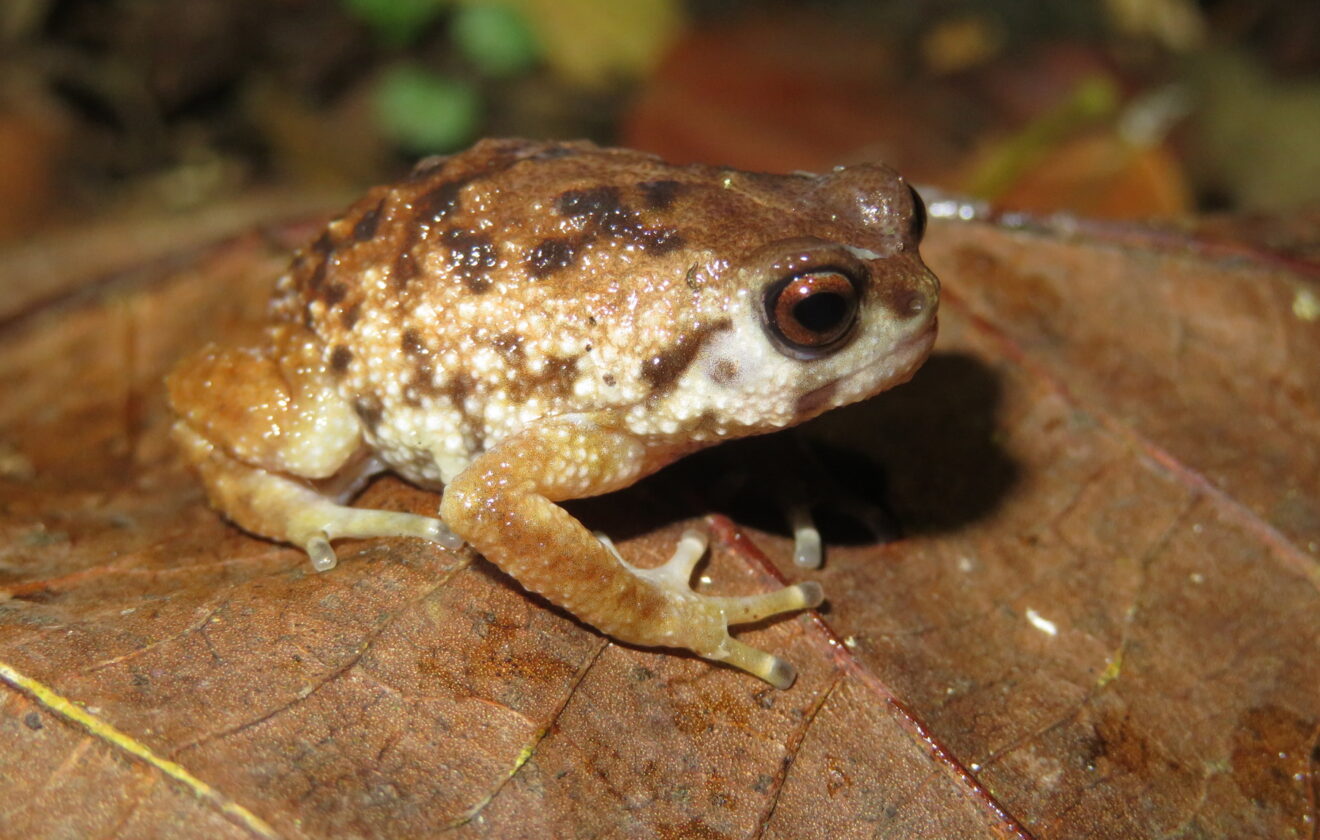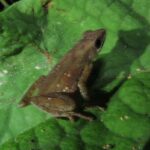- Secrets of the Shengena Warty Frog: A Deep Dive into <em>Callulina shengena</em>
- Introduction: A Hidden Gem Among the Branches
- Taxonomy and Classification: Understanding Its Relatives
- Natural Habitat: Life Among the Misty Peaks
- Physical Characteristics: Adapting to the Mountain Mists
- Behavior and Life Cycle: Secrets of Survival
- Ecological Role: Guardians of Forest Balance
- Threats and Conservation Status: A Frog on the Brink
- Cultural and Scientific Significance: A Message from the Mountains
- Conclusion: Protecting a Living Legacy
Secrets of the Shengena Warty Frog: A Deep Dive into Callulina shengena#
Introduction: A Hidden Gem Among the Branches#
Hidden deep within the mist-draped forests of Tanzania’s enigmatic Shengena peak, a remarkable amphibian lives quietly in the shadows. The Shengena Warty Frog, scientifically dubbed Callulina shengena, may be small in stature, but its ecological impact and intriguing adaptations have become increasingly captivating to scientists and nature enthusiasts alike.
Discovered relatively recently, in 2011, Callulina shengena immediately drew attention due to its fascinating appearance, remarkable climbing abilities, and highly specialized habitat. A quiet forest dweller cloaked in bumpy, mottled skin, this species serves as a poignant reminder of how much undiscovered wonder is hidden in overlooked corners of our planet, and how urgently we need to protect such delicate ecosystems. Join me now as we journey into the world of the Shengena Warty Frog—a story about resilience, adaptation, and delicate ecological balance.
Taxonomy and Classification: Understanding Its Relatives#
Belonging to the family Brevicipitidae, the genus Callulina comprises small, secretive frogs commonly known as warty frogs. Within this unique lineage, Callulina shengena stands apart due to subtle yet distinct morphological differences, genetic traits, and localization. Its closest cousins, which share the genus, inhabit similar mountainous regions scattered across Eastern Africa, each species elegantly adapted to its own micro-environment.
Notably, the warty frogs represent an evolutionary marvel of adaptability, showcasing how isolated montane forests can spawn extraordinary diversity within even closely related species. Genetically distinct yet outwardly subtle, the differentiation among Callulina species underscores the profound role geographic isolation plays in species evolution.
Natural Habitat: Life Among the Misty Peaks#
Geographic Range and Distribution#
Callulina shengena is endemic to the North Pare Mountains of Tanzania, specifically confined to the misty and rugged forests blanketing Mount Shengena. The mountain, shrouded in mystery, rises conspicuously from the Tanzanian landscape, supporting a cloud-draped environment of moss-laden branches, dense shrubbery, and concealed crevices with constant moisture essential for amphibian life.
Habitat Preferences: The Fragile Forest Shadows#
Within its relatively small range, the Shengena Warty Frog prefers moist, montane evergreen forests at elevations between 1,900 and 2,400 meters. Here, low clouds often settle, providing delicate humidity and consistent moisture crucial for the frog’s survival. Unlike many frogs that favor pools or slow-moving streams, this species spends most of its time safely hidden among damp leaf litter, boulders, or clinging atop water-rich mosses found on trees and fallen logs. This adaptation allows it to exploit a niche few predators and competitors can reach.
The Shengena forests, enchanted and primeval, support intricate ecological webs, sustained largely by continual moisture captured by high-altitude clouds—a life-giving fog that embraces the mountain like a gentle hand. It is this very delicate balance that the petite but resourceful Callulina shengena depends on fully.
Physical Characteristics: Adapting to the Mountain Mists#
The Shengena Warty Frog is best described as modestly sized, generally measuring between 25 and 35 millimeters—the length of a small thumb. However, despite its demure stature, the frog possesses striking features that uniquely adapt it to its secluded lifestyle.
Its skin, the most prominent feature, is densely covered with small wart-like protrusions, hence its colloquial name. Ranging from subtle browns and grays to earthy green tones flecked with mottles of darker colors, their coloration offers near-perfect camouflage among lichen-covered bark, rocks, and leaf litter. This cryptic coloration facilitates discreet hiding, an invaluable tool for survival in an environment teeming with potential predators.
Moreover, the species displays pronounced padded digits, equipped with gripping features that enable adept climbing and gripping on slippery mossy surfaces. This trait, combined with their robust limbs, allows them to navigate their arboreal and terrestrial habitats effectively, safely seeking food and shelter high above the forest floor.
Behavior and Life Cycle: Secrets of Survival#
Diet and Feeding Behaviors#
Callulina shengena, like many amphibians, is primarily insectivorous, feeding largely on small insects and arthropods. Its hunting strategy is cautious yet deliberate—waiting patiently in concealed spots for unsuspecting prey before quickly striking. Often, it leverages its cryptic coloration to blend with surrounding environments, employing patient stealth rather than energetic pursuit.
Mating and Reproduction: Silent Calls in Misty Twilight#
Vocalizations are notably subtle in warty frogs, but males emit soft chirping notes, most pronounced during periods of abundant rainfall. Breeding coincides with wetter periods, ensuring moisture for egg development. Interestingly, Callulina species are known to lay eggs in subterranean nests or tucked carefully within the protective confines of damp leaf litter or moss, bypassing a traditional aquatic larval stage entirely.
This direct development, known as terrestrial breeding, produces fully formed froglets that hatch directly from eggs—an adaptation perfectly suited to their montane habitat, which often lacks standing water bodies necessary for more conventional amphibian larvae to develop.
Ecological Role: Guardians of Forest Balance#
Though small, the ecological importance of Callulina shengena is significant. As key insect predators, these frogs contribute to controlling insect populations, thus maintaining a delicate ecological balance. Additionally, the presence and abundance of these frogs serve as critical bio-indicators. A decline of frog populations signals broader ecological distress, warning of environmental degradation long before more obvious symptoms emerge.
Furthermore, these frogs form an essential dietary component for local predators, including birds and small mammalian carnivores, embedding them firmly into the forest’s intricate trophic webs. Despite their secretive habits, warty frogs play indispensable roles in maintaining the ecosystem’s stability, quietly but effectively underpinning the forest’s delicate harmony.
Threats and Conservation Status: A Frog on the Brink#
Currently, this unique amphibian is considered endangered by the International Union for Conservation of Nature (IUCN), reflecting its limited distribution and the ongoing threats to its habitat. The primary danger confronting the Shengena Warty Frog is habitat destruction driven by human agricultural expansion, illegal logging, and climate instability altering crucial environmental parameters.
Climate shift, indeed, poses an unprecedented threat. As global temperatures rise, mist and cloud formations critical for survival may dissipate or shift upward beyond suitable habitats. This loss of moisture profoundly impacts local amphibian populations, pushing these delicate creatures ever nearer to extinction.
Thankfully, conservation efforts focusing on protecting and restoring mountain forest habitats are actively underway. Numerous local NGOs and global organizations aim to encourage more sustainable land practices, educate local communities, and advocate for formal habitat protections.
Cultural and Scientific Significance: A Message from the Mountains#
The Shengena region, infused with cultural richness among indigenous communities, respects and recognizes biodiversity’s inherent worth. Local lore often highlights amphibians as symbols of health and fertility, and the presence of species like Callulina shengena thus resonates deeply culturally and financially through ecotourism and heritage-based conservation.
Scientifically speaking, each Callulina species holds potential discoveries waiting to be unraveled. Their unique adaptations and reproductive strategies promise insights into evolutionary biology, developmental biology, and ecology, potentially offering guidance for broader conservation initiatives globally.
Conclusion: Protecting a Living Legacy#
In the delicate ecosystems of Tanzania’s forested mountains, Callulina shengena lives as an amphibian emblem of adaptation and survival. Its existence reminds us of biodiversity’s intricate beauty and fragility, a reason more compelling than ever to support and advocate for comprehensive conservation measures.
By learning about—and from—this remarkable frog, we not only enrich our own understanding but also strengthen the collective commitment to preserving our fragile natural world. It’s time to amplify our efforts, take action, and protect wonders hidden among misty peaks and warty skins, ensuring Callulina shengena continues its quiet reign within Tanzania’s precious forests.








